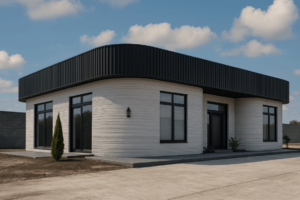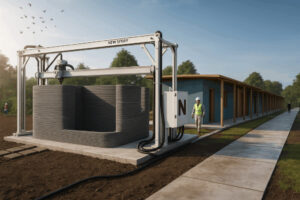
Ukraine could attract up to €4 billion in private investment and create more than 17,000 jobs thanks to innovative construction, which includes the use of geopolymers, hempcrete, and 3D printing, according to a report by the International Finance Corporation (IFC) of the World Bank Group, “Rebuilding Ukraine: Opportunities for Investment in Innovative and Sustainable Construction.”
“As of the end of 2024, 13% of the total housing stock had already been damaged or destroyed, and a significant part of the country’s infrastructure had been affected in all major sectors (e.g., energy, transport, telecommunications, industry, social sector). The total investment needs for restoration and reconstruction were estimated at over $0.5 trillion over a decade, with housing accounting for the largest share,” the report says.
The IFC emphasizes that reconstruction creates an opportunity to build housing in a better and more efficient way, and the study identifies promising building materials and technologies that can help achieve this and build hundreds of millions of square meters of new, energy-efficient construction.
At the same time, the authors of the document note that private investment in innovative construction is hampered by a number of obstacles, including regulatory barriers, limited access to financing, low levels of education in the industry, and a shortage of skilled workers.
According to the study, Ukraine needs additional production capacity: 8 million tons of geopolymers, with an estimated investment of $1.36 billion, 6 million square meters of precast reinforced concrete – $1.5 billion, 0.7 million tons of basalt wool – $420 million, 0.1 million tons of basalt reinforcement – $420 million.
This list also includes the creation of capacity for the production of 0.5 million tons of hemp concrete, which requires $20 million in investment, 1 million cubic meters of autoclaved aerated concrete (AAC) – $100 million, 3D printing for construction – $50 million, and special glazing for 8 million square meters – $72 million.
3D PRINTING, geopolymer, innovative construction, INVESTMENT

Scientists from the Kyiv National University of Construction and Architecture (KNUCA), together with partners, have launched an international project to create new concrete mixtures using waste, in particular, destroyed structures, for construction using 3D printing and traditional methods, according to the KNUCA press service.
The release states that as part of the project “Development of new approaches and construction materials for the restoration of Ukraine’s damaged infrastructure with consideration for environmental sustainability,” researchers are developing a concrete mixture with the addition of materials resulting from the destruction of buildings and other industrial and agricultural waste.
The restoration of housing in Ukraine requires the introduction of universal technologies for rapid construction that allow for the construction of sustainable and affordable buildings even in conditions of limited resources. Due to the war, many buildings in Ukraine have been destroyed. The remains of concrete structures can be effectively recycled and used for the construction of new housing. Compared to traditional construction methods, 3D printing of buildings can ensure faster construction rates, significantly reduce human resource use, and save materials and energy.
The project is co-funded by the US Office of Naval Research and the US National Science Foundation (NSF). The research is being conducted as part of the multilateral partnership initiative “International Multilateral Partnership for Ensuring the Sustainability of the Education and Science System in Ukraine (IMPRESS-U), launched by the Office of International Science and Engineering (OISE) of the US National Science Foundation with the participation of researchers from Stony Brook University in the US and the Jan and Jędrzej Sniadecki University of Technology in Bydgoszcz, Poland.
The project will last two years.
At KNUBA, the implementation of this project has been entrusted to lecturers, postgraduate students, and students of the Faculty of Construction and Technology, in particular, the Department of Building Materials and the Department of Building Structures and Products Technology.

Scientists from the Kyiv National University of Construction and Architecture (KNUCA), together with partners, have begun implementing an international project to create new concrete mixtures using waste, in particular, destroyed structures, for construction using 3D printing and traditional methods, according to the KNUCA press service.
The release states that as part of the project “Development of new approaches and construction materials for the restoration of Ukraine’s damaged infrastructure with consideration for environmental sustainability,” researchers are developing a concrete mixture with the addition of materials resulting from the destruction of buildings and other industrial and agricultural waste.
The restoration of housing in Ukraine requires the introduction of universal rapid construction technologies that allow for the construction of sustainable and affordable buildings even in conditions of limited resources. Due to the war, many buildings in Ukraine have been destroyed. The remains of concrete structures can be effectively recycled and used for the construction of new housing. Compared to traditional construction methods, 3D printing of buildings can ensure faster construction rates, significantly less use of human resources, and savings in materials and energy.
The project is co-funded by the US Office of Naval Research and the US National Science Foundation (NSF). The research is being conducted as part of the multilateral partnership initiative ” International Multilateral Partnership for Ensuring the Sustainability of the Education and Science System in Ukraine (IMPRESS-U),” initiated by the Office of International Science and Engineering (OISE) of the US National Science Foundation with the involvement of researchers from Stony Brook University in the US and the Jan and Jędrzej Śniadecki University of Technology in Bydgoszcz, Poland.
The project will last two years. At KNUBA, the implementation of this project is entrusted to teachers, graduate students, and students of the Faculty of Construction and Technology, in particular, the Department of Building Materials and the Department of Building Structures and Products Technology.

TitanEra LLC (Dnipro), associated with the developer of titanium ores – Production and Commercial Company Velta LLC, has completed the 3D printing line and launched the first printer for the production of finished titanium products from powder using its own technology.
“Our pilot plant continues to receive new equipment, and we are starting to complete the 3D printing line. The first printer was launched the other day… We have not only printed a test sample, but also the first private order for medical equipment. We really hope to start to produce test samples for defense and space in the near future,” CEO and co-owner of Velta and TitanEra LLC Andriy Brodsky wrote on Facebook.
At the same time, he said that when choosing equipment, the choice fell on the Ukrainian manufacturer of printers. “Ukrainian final product from Ukrainian titanium powder according to Ukrainian technology, produced from Ukrainian raw materials, should definitely be printed using Ukrainian technology,” Brodsky said.
According to him, 3D printing has complemented the range of other powder pressing and rolling technologies used by the company.
“And I believe most of all in titanium 3D printing, despite the technological difficulties that the whole world, including our TitanEra, is now solving. By expanding the range of methods, we are expanding our sales market,” the CEO added.
As reported, TitanEra is a Ukrainian company based on 15 years of experience of the Velta team in the global titanium industry.